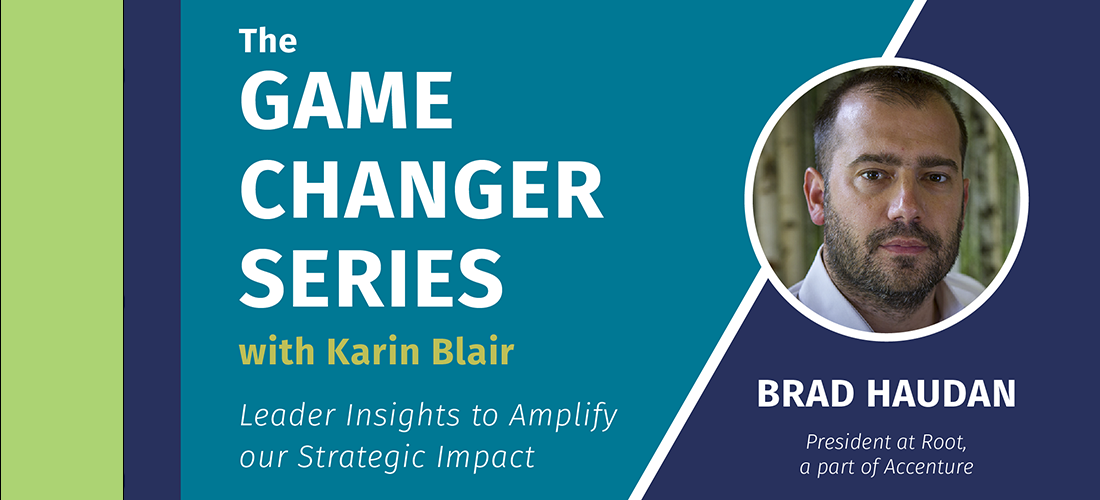I recently had the honor of being a part of Karin Blair‘s Game Changer Series which is designed to inspire game-changing strategic leadership – an elite level of performance estimated to be achieved by about 5% of leaders today. Leaders like Indra Nooyi, Herb Kelleher and Howard Schultz.
It features insights and experiences from innovators, creators, leaders, authors and strategic leadership experts – each working at a current edge of discomfort to amplify their strategic impact and transform the future of leadership. Each guest is invited to take Karin’s Strategic Impact Quiz, which identifies where they are on their journey to game-changing strategic leadership – are they a THINKER, PLANNER, CREATOR? Or have they achieved the elite performance level of a TRANSFORMER?
Below is an excerpt of my interview with Karin on how to engage people in your strategy story:
Q (Karin): As an expert in strategy activation, what is your top advice for individual leaders to turn their strategies into reality?
A (Brad): Rightfully so, a lot of focus and attention is applied to the definition of strategy. However, far less is applied to activating the strategy through your people. And it’s often the execution of strategy, not the definition, that creates competitive differentiation. So my advice would be to apply just as much focus to activation as you do definition. More specifically, ensure (1) Your top leaders have the requisite clarity and conviction for the strategy, your employees down to the front line understand the why, what, and how of the firm’s strategic direction, and (2) You have a capability development plan that is uniquely tailored to the key differentiators of your strategy.
Q (Karin): What is one challenge of strategic leadership that you’ve most consistently seen with your clients? What advice do you have for other leaders to avoid these obstacles?
A (Brad): Be patient, and go slow to go fast later. It takes a patient leader to take the time to enroll their teams, their teams’ teams, and the rest of the organization. The senior most leaders often forget what it’s like to “not know” or said differently “not be as clear.” When done well, this patience pays off in accelerated execution. For the typical ‘Type A’ CEO this can, understandably so, be very difficult.
Q (Karin): Indeed – so many of us leaders are driven, and impatient. What advice do you have to help these leaders decide “how far and how fast” when leading change?
An organization will move at the speed of the slowest many, not the brightest few
A (Brad): My simplest advice is an organization will move at the speed of the slowest many not the brightest few. If you keep that in mind, you’ll tailor your actions to the activities and behaviors that will have the biggest impact.
Q (Karin): Your organization has been a leader in bringing the creative and experiential to strategy activation. How would you advise leaders on balancing the analytic and creative as they approach their own strategy definition and activation?
A (Brad): For many decades, new product development and innovation companies have intrinsically understood that they are developing for the “end-user” or consumer, and this is often referred to as “user-centered design.” They also understand there is not one consumer profile in the marketplace. Organizations are the same, they are made up of a wide range of individuals with various learning styles.
However, at the very top of the world’s largest organizations the story of their business is often authored in a linear and heavily analytical PowerPoint Deck. Strategy decks are littered with charts on total addressable market (TAM), growth rate, and margin potential – often all on the same slide! We’ve gotten really good at making the complex more complex instead of making the complex more simple so that the information can be democratized, absorbed, and embraced by all.
The best strategy functions and executive teams I’ve worked with understand that their employees are the end-users of the strategy they author, and they engage their people in the story of the strategy in a way that fosters dialogue and curiosity.
Visualization, storytelling, creative, and active engagement helps to make the story of the business more digestible to those responsible for turning those visions into results.
Q (Karin): Strategic leadership is a series of tricky balancing acts. Which ones are top of mind for you these days?
A (Brad): On the heels of the COVID pandemic, where many of life’s assumed norms were shattered, I’m finding many leaders are having to quickly develop capability in how they provide clarity of direction but also coach and teach independent thinking & agility at the same time. The last few years were a crash course in agility, but I’m seeing clients start to chart multi-year growth paths again while also recognizing more than ever that leaders have to quickly react to changing market conditions.
This paradox of the AND can be challenging because at one extreme we are a directionless organization, and at the other extreme we are slow to change and adapt; neither an enviable place to be. This concept is not new, but the focus on developing this muscle at scale within organizations is a much greater focus than I’ve seen in the past.
Q (Karin): I believe leaders must learn to manage core fears associated with strategic leadership – like the risk of incompetence, rejection, or failure. Have you seen these at play? And what advice do you have in managing them for greater strategic impact?
A (Brad): We are fortunate enough to support some of the world’s largest organizations and best brands in the world. And the ones I’m most impressed with lately have completely moved away from the functional leader that, perhaps struggling with the risk of incompetence, holds the cards of information close to their vest and shares it on a need-to-know basis. Instead, they are recognizing, rewarding and developing the leader that seeks to understand, brings a natural curiosity, and is okay saying “I don’t know,” “tell me more.” These leaders accept the ambiguity and uncertainty of strategic decisions. They excel at extracting and sifting through qualitative and quantitative information and make a quality business decision in a timely manner. And in the best organizations, that business decision is driven by the business strategy so that the resources and efforts of the firm are aligned to a common direction.
In a world today, where employees are picking their employer just as much as employers are picking employees, I’m betting on the firms developing leaders in this manner because I believe they’ll make better business decisions, retain the right talent, and grow at an accelerated pace.









